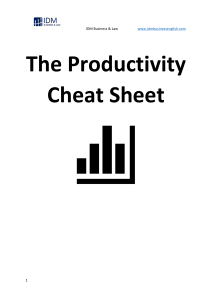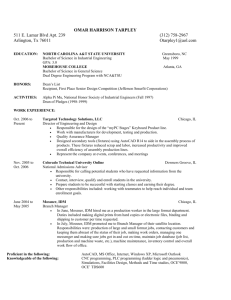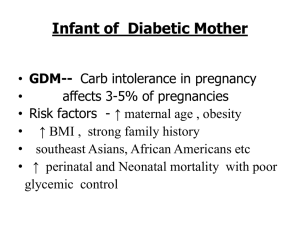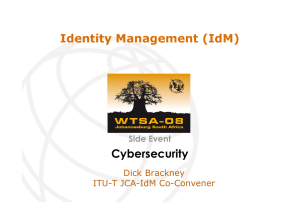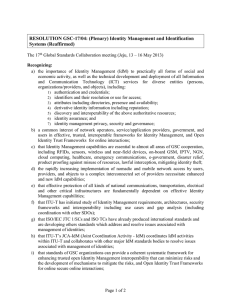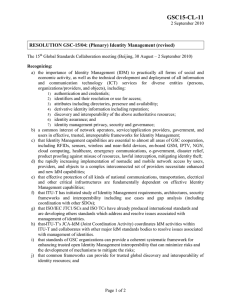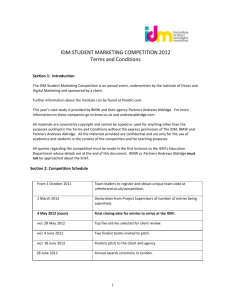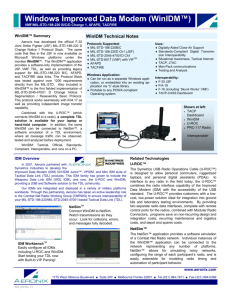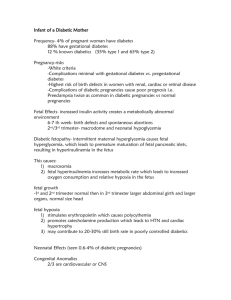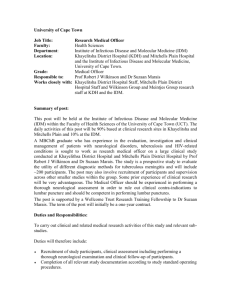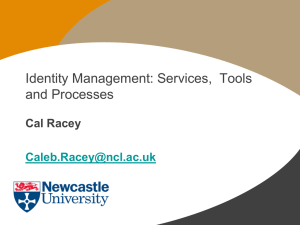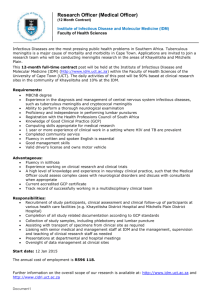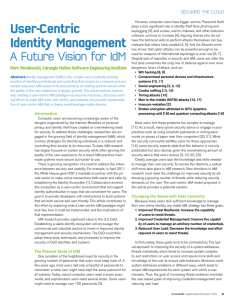Direct and Digital Marketing Strategy
advertisement
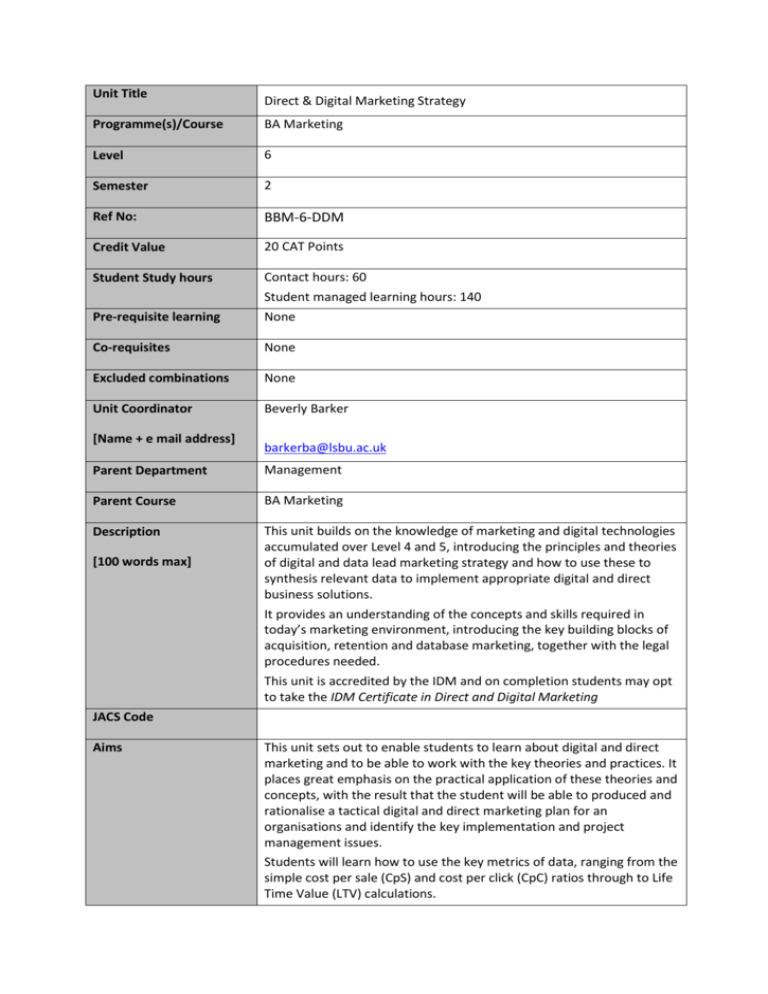
Unit Title Direct & Digital Marketing Strategy Programme(s)/Course BA Marketing Level 6 Semester 2 Ref No: BBM-6-DDM Credit Value 20 CAT Points Student Study hours Contact hours: 60 Student managed learning hours: 140 Pre-requisite learning None Co-requisites None Excluded combinations None Unit Coordinator Beverly Barker [Name + e mail address] barkerba@lsbu.ac.uk Parent Department Management Parent Course BA Marketing Description This unit builds on the knowledge of marketing and digital technologies accumulated over Level 4 and 5, introducing the principles and theories of digital and data lead marketing strategy and how to use these to synthesis relevant data to implement appropriate digital and direct business solutions. It provides an understanding of the concepts and skills required in today’s marketing environment, introducing the key building blocks of acquisition, retention and database marketing, together with the legal procedures needed. This unit is accredited by the IDM and on completion students may opt to take the IDM Certificate in Direct and Digital Marketing [100 words max] JACS Code Aims This unit sets out to enable students to learn about digital and direct marketing and to be able to work with the key theories and practices. It places great emphasis on the practical application of these theories and concepts, with the result that the student will be able to produced and rationalise a tactical digital and direct marketing plan for an organisations and identify the key implementation and project management issues. Students will learn how to use the key metrics of data, ranging from the simple cost per sale (CpS) and cost per click (CpC) ratios through to Life Time Value (LTV) calculations. 20 Credit Translation Document Sept 2010 Learning outcomes Knowledge and Understanding: On completion of this unit students will have 1. A comprehensive knowledge of direct and digital marketing theories and how they can be applied to provide strategic business solutions (A1, A3, A6) 2. A knowledge of the professional and legislative codes that inform and shape direct and digital solutions and an understanding of ethical issues relating to personal data (A1) Intellectual Skills: On completion of this unit student will be able to: 1. Apply a range of direct and digital marketing communication tools and techniques to make appropriate tactical recommendations to improve marketing effectiveness (B1, B2) 2. Synthesis customer data and market insights to draw conclusions and propose relevant, profitable recommendations in the form of acquisition and retention plans (B5) 3. Evaluate database technologies to enhance customer insights to improve marketing effectiveness (B4) Practical Skills: Students acquire and develop practical skills such that they are able to: 1. Operate in a complex and unpredictable environments to set specific goals for digital and direct channels and align these with business goals (C1, C2) 2. Write a strategic marketing campaign plan incorporating digital, direct and database marketing techniques (C4, C7) 3. Apply budgeting and forecasting techniques to marketing tasks (C4) 4. Make proposals as to how to collect relevant customer data from own and external sources (C5) Employability Transferable Skills: Students will develop transferable skills such that they are able to: 1. Develop, implement, manage projects autonomously and work to deadlines (D3) 2. Prepare and communicate effectively through written and oral business reports (D2) 3. Work with computers and major office software (D7) 4. Work with numbers (D6) Digital and Direct marketing are growth areas within ‘marketing’ and many opportunities exist for those interested in this field. These include working on the ‘client side’ in marketing departments for commercial, public sector and non-for-profit organisations that incorporate digital and DM into their customer or donor communications mix. Additionally, many advertising agencies have established digital and direct divisions and new specialist support service companies are growing to provide data planning, data warehousing, search engine optimisation, direct mail and fulfilment services. In support of this, the Institute of Direct Marketing (IDM) exists to set and recognise the highest standards of practice across the UK and Ireland. They are committed, with the support of the Royal Mail, to 2 20 Credit Translation Document Sept 2010 ensuring that universities and colleges are able to deliver the best interactive and direct marketing teaching and ensure a good stream of bright, talented and knowledgeable students to work in the interactive and direct marketing professions. Their web site www.theidm.com and student support site www.urthebrand.co.uk will be a valuable source of research material for the successful completion of this unit. IDM Graduate Summer School: Students who demonstrate a desire to work in this area can apply for the IDM Graduate Summer School – a week long introduction to the direct, data and digital marketing profession, supported by leading companies and agencies, many of whom recruit direct from the weeks course. IDM Certificate in Direct and Digital Marketing: In addition, students who wish to take the IDM Certificate in Direct and Digital Marketing for a small enrolment fee of £65 + VAT gaining an additional qualification along with their university education. Teaching & Learning Pattern Indicative content The unit will be taught using formal lectures and seminar sessions. Case studies will be used in the seminars to expand on topics covered in the lecture. Students will also spend some of the seminar time in the computer laboratories researching and experience individual topics, such as costing and setting up a search campaign, first hand. The blackboard site is integral to the delivery of this unit. Alongside being a repository for all lectures and information relating to the unit, the seminar section will contain your seminar instructions, including many of the hyperlinks and log in details that you will need to complete your seminar work Introduction, theory and definitions of direct and digital marketing Looking at the definition of data and direct marketing, what makes them different and how the new digital channels affecting marketing. Planning requirements and processes including budgeting Building on the planning work undertaken at Level 4 and 5, students will learn how to identify DM orientated issues, using techniques such as SOSTAC, to form objectives and strategies to deliver an action plan. Databases—data collection, management and the law Students will build their knowledge of the use of databases in planning, measurement and forecasting, along with the main elements of data protection and requirements for collecting and storing data. Students will look at customers and prospects segmentation in relation to targeting and learn about UK profiling and segmentation sources and learn how segmentation systems such as CHAID are built and modelled. Introduce the concepts behind building behavioural and psycho-graphic profiles for value proposition development Customer Acquisition— theory, planning and implementation The principles of ‘customer acquisition’, looking at 'The Customer 3 20 Credit Translation Document Sept 2010 Journey', how brand perceptions and buyer behaviour influence customer acquisition strategy and ability to attract new customers. Structuring an acquisition plan, incl. setting objectives and identifying target. Setting benchmarks and using the concept such as Lifetime Value (LTV). Implementation overview of core direct and digital marketing media, how the various media channels can be used and what factors need to be considered when dealing with and measuring response and fulfilment. Retention—theory, principles and implementation Defining and understanding the importance of customer retention exploring the principles of CRM and loyalty programmes and how to optimise LTV, evaluating case studies such as Tesco, etc., learning how to use media channels such as email and direct mail to aid retention. Testing and Managing response Introducing testing principles and methods to ensure students understand how to plan a valid test campaign building on the understanding of using databases for forecasting and market research. Creative practices and strategies Exploring specific creative issues and techniques developed within digital and direct, looking at creative briefing & AIDCA. Investigating how the medium and message work together. 4 20 Credit Translation Document Sept 2010 Assessment method (Please give details – elements, weightings, sequence of elements, final component) This unit is assessed through three pieces of coursework. The weightings are as follows: Group presentation - 35% In groups of 4-5 conduct comprehensive situation analysis, incl. PEST, SWOT & 5S’s etc analysis, distilled down into the key issues and resulting digital & direct marketing objectives required to deliver the corporate goals. The company under review will be identified from the IDM student competition case study and supplied to students. Presentations to be undertaken in weeks 9 & 10. Individual data analysis exercise - 15% Based upon a set of company raw data metrics requiring further calculation and interpretation to identify key indicators, such as Cost per contact (CPC), cost per sale (CPS), lifetime value (LTV) and return on investment. Coursework deadline Week 12. Individual written report and preparation of digital marketing plan 50% Students are required to build on the key issues made within their group presentation and derive individual direct and digital marketing proposals. These will include Acquisition objectives, key strategies (incl. web and customer database strategies), target audience segmentation, key message strategies and recommendations of channels & tactics to be utilised to fulfil objectives. Development of a first-phase Retention plan, including Retention objectives, segmentation and contact strategy. Students must consider both creative, media and legal issues within their recommendations. Deadline: Week 15 Indicative Reading CORE READING: 1. Chaffey D & Smith PR (2008) E-Marketing Excellence, Butterworth Heinemann 2. Strauss J., & Frost R (2009) E-Marketing, 5th Edition, Pearson International 3. Thomas, B., & Housden, M., (2009), Direct Marketing in Practice, Elsevier (ISBN 0-7506-2428-0) OPTIONAL READING: 1. Bird, D., (2007) Commonsense Direct & Digital Marketing (5th Ed), Kogan Page (ISBN 9780749447601) 2. Adamson, A.P. (2008) Brand Digital: Simple Ways Top Brands Succeed In The Digital World, Palgrave Macmillan 3. Godin, S (1999) Permission Marketing: Turning Strangers Into Friends And Friends Into Customers, Simon & Schuster, 4. Godin, S (2007) Meatball Sundae: Is Your Marketing out of Sync? Penguin Books Ltd. 5. Godin, S (2008) Tribes: We Need You to Lead Us, Penguin Books Ltd. 6. Godin, S (2009) Purple Cow: Transform Your Business by Being Remarkable, Penguin Books Ltd. 5 20 Credit Translation Document Sept 2010 7. Mahwah, N.J (2005) Online Consumer Psychology: Understanding and Influencing Consumer Behaviour in the Virtual World; Lawrence Erlbaum Associates 8. McDonald Malcolm, Wilson Hugh, (2005) The New Marketing: Drive the Digital Market or It Will Drive You, Butterworth Heinemann, 9. Scott, D.M.(2008) The New Rules Of Marketing And PR: How To Use News Releases, Blogs, Podcasting, Viral Marketing And Online Media To Reach Buyers, John Wiley 10. Sernovitz, A (2009) Word of Mouth Marketing: How Smart Companies Get People Talking, Revised Edition, Kaplan 11. Thorne, L, (2008) Word-Of-Mouth Advertising, Online And Off : How To Spark Buzz, Excitement, And Free Publicity For You, Atlantic Pub. Group Other Learning Resource: Journals Journal of Marketing Management New Media Age, Centaur Communications The Journal of Direct, Data and Digital Marketing Practice The Journal Of Interactive Advertising The Journal of Marketing Research Useful Web Sites: The IDM, U R the Brand (IDM student resource) Think Direct Brand Republic ABC ASA DMA Committee of Advertising Practice E-mail preference Service Mailing Preference Service Information Commissioner’s Office www.theidm.com www.urthebrand.co.uk/ www.think-direct.com www.brandrepublic.com www.abc.org.uk www.asa.org.uk www.dma.org.uk www.cap.org.uk www.e-mps.org www.mpsonline.org.uk www.ico.gov.uk 6
